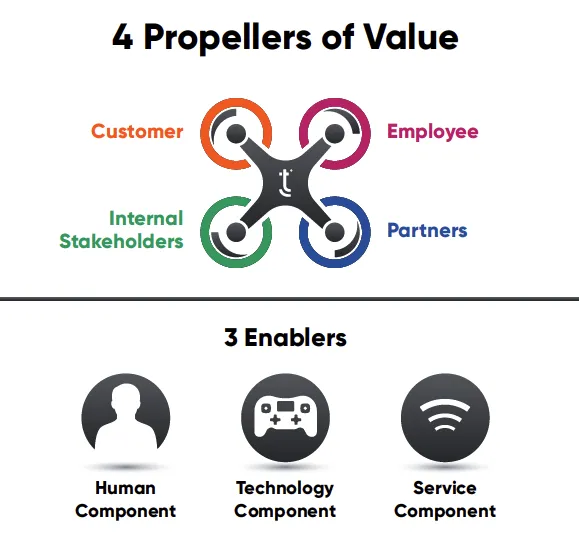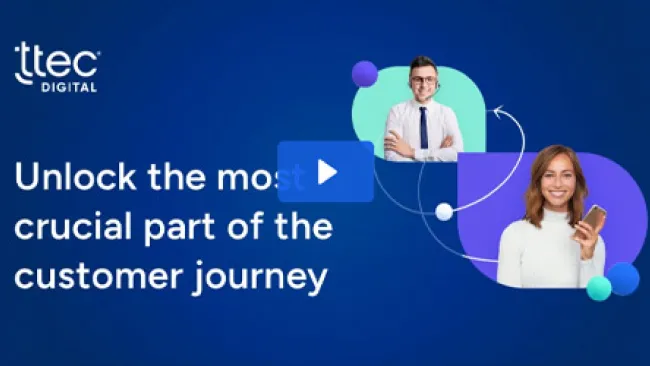Last Christmas, my son Emerson received his first drone as a gift from his grandparents. He was so excited and couldn’t wait to get out and use it - but unfortunately, despite many attempts, he couldn’t get the drone to fly right. Two of the propellers didn’t work; it was basically flying sideways – and then shortly after, stopped ‘working’ altogether.
Frustrated with his initial drone experience, as his birthday rolled around in April, Emerson added “a drone that works” to the top of his wish list.
Emerson’s drone experience has numerous parallels to what we all-too-commonly see in the CX space. For a drone (or a customer experience) to “fly right,” numerous components must be orchestrated and balanced effectively – and for CX, it’s very much the same thing, with many pieces to consider.
I was honestly (and unfortunately) not at all surprised by the drone’s failure and Emerson’s ultimate disappointment, as I knew all too well the key upstream inputs to this failed ‘value chain’: My dad’s (i.e., Emerson’s grandfather’s) decision making process. His criteria were all about:
- Convenience (“I’ll buy it on my next trip to the store”)
- Price (He’s cheap, and believes “the kids will quickly lose interest and/or break it anyway”)
- Utter cluelessness on proper drone selection and buying criteria
In short, he was in no way qualified for this drone buying experience and used only the simplest of analysis to make a decision: “Ooh, that says ‘drone’, and it’s cheap. Done.”
Now, as much as I like to pick on my dad, his intent was NOT to disappoint Emerson – in fact, quite the opposite. He loves watching that kid light up when he’s having fun, and for the sake of this discussion, we might say he derives immense ‘value’ from Emerson’s happiness. So, when this crappy drone didn’t provide the experience and value Emerson expected, we witnessed an epic value disaster.
This anecdote raises an interesting and important question: How do we define value? If you ask 10 people, you’ll likely get 10 different answers. Value is a very commonly used, broad term – one that is hard to define and measure consistently. And this same concept – that of specifically defining value - has been a continual, elusive challenge for companies and enterprises of all sizes.
What IS value anyway?
In the book “Pricing and Profitability Management: A Practical Guide for Business Leaders,” the authors cite three examples of value theory concepts: value defined by production and labor inputs, value determined by lack of resource availability, and value defined by benefits received. These concepts provide a toolkit for organizations to gain clarity on how they define and deliver value. That’s more important than ever, because consumers are examining and considering value much differently now – and it is significantly impacting their purchasing and ongoing consumption decisions.
Don’t believe me? Look no further than a recent McKinsey study that found many consumers’ active willingness to switch and/or try new brands over the past year. “Of the three quarters of Americans who changed their shopping behavior since COVID-19 began, around 40% say they have changed brands, with the level of brand switching doubling in 2020 compared to 2019,” according to the study.
And while my dad will be happy to know that he’s not alone in considering price to be a significant determinant of value, it is hardly the full story. In fact, 1 in 3 consumers now say they consider purpose-driven companies when making purchasing decisions – and 42% of millennials cite this as a primary influence. In addition to the brand-switching and purpose-driven influences, COVID has triggered new digital behavior in buyers, and the demand for such digital experiences will continue to increase.
Value needs balance to keep experiences flying high
Aside from drones, we at TTEC believe it’s time to radically rethink and redefine value in the CX and contact center worlds. To date, value has been largely focused on lowest price for services at all costs, with those services being primarily human-enabled (i.e., contact center agents). Quite simply, this just won’t cut it going forward. This very narrow view fails to align with evolving and more sophisticated consumer demands and buying behaviors noted above – that is, an expanded view of value.
Instead, we see value as a balancing act across four key stakeholders that are key to unlocking it:
- Customers
- Employees
- Internal Stakeholders
- Partners

These four stakeholder groups have very distinct and important perspectives to carefully consider, without over-rotating on any specific one – lest they risk their CX value proposition steering violently sideways like Emerson’s errant drone. All four perspectives must work in harmony to create the perfect balance of CX value delivered – kind of like the four propellers typical to most drones! If even one propeller is off or sub-optimized, the drone won’t fly correctly. The drone owner will get frustrated (like Emerson) and will eventually choose a different drone – just like consumers who walk away and try new brands that offer superior experience(s) and value.
And the story doesn’t end there. Even if/when we embrace this evolved and balanced view of our CX design and value story, we still need to figure out how to execute. Execution always comes down to success in three areas, which also like a drone requires balance and coordination among them:
- Humanity
- Technology
- Orchestration (Services)
A great CX program, like a great drone, needs a drone pilot (labor), a remote control (technology), and the signal or frequency (orchestration / services) to make it all work, just to name a few enablers to execution.
CX value: You’re doing it wrong
While it pains me to say this, I’ll be blunt: Most companies are NOT delivering on this evolved view of CX value – not even close. If they were, we wouldn’t be seeing some of the troubling trends noted in the data above.
We’re here to break down these issues and components, talk about them, and offer practical and pragmatic tips to dramatically improve this predicament faster than you might imagine.
This is the first in an ongoing series we’re calling “CX Value: Worth more than you think.” As we progress through this complex story, we will be exploring in depth the Stakeholders and Enablers noted, including specific measures for each. Our intent is to spur action, not just pontificate.
A few hints as to what’s in store, and what you can start thinking about:
- The channels you offer to your customers to reach you are far from optimized or ideal – and we’ll explain why
- Your ‘last-mile’ CX Ambassadors/Agents are working way too hard – and that can be improved meaningfully in less than 30 days
- The technology that you bought, and/or are in the process of buying, will not work as you expect out of the box – don’t let the slick demo fool you
We’ll also keep this series fun and interactive, and hopefully create a space to share ideas and learn from one another using familiar stories. For instance, we’ll talk about what we can learn from giraffes that can dramatically improve your CX value…. Stay tuned, and we hope you enjoy the ride!
















